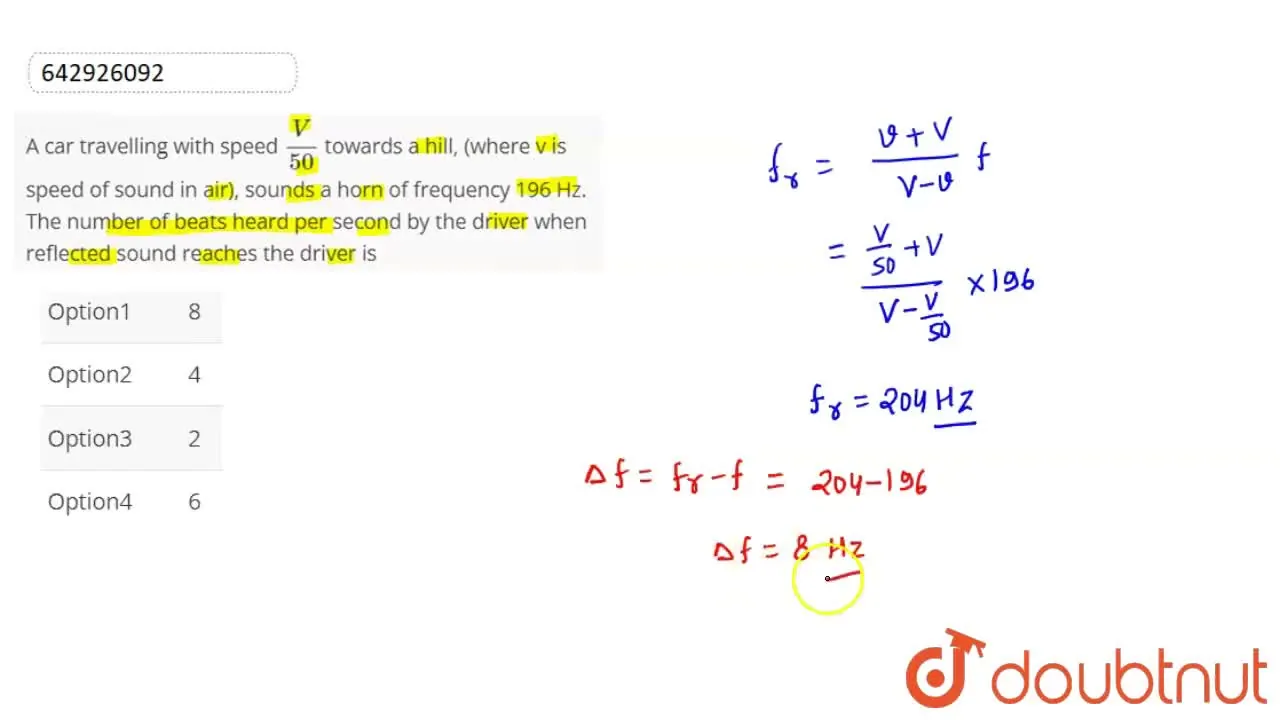A car travelling with speed V50 towards a hill, (where v is speed of sound in air), sounds a horn of frequency 196 Hz. The number of beats heard per second by the driver when reflected sound reaches the driver is
8
4
2
6
Step by step video & image solution for A car travelling with speed V/50 towards a hill, (where v is speed of sound in air), sounds a horn of frequency 196 Hz. The number of beats heard per second by the driver when reflected sound reaches the driver is by Physics experts to help you in doubts & scoring excellent marks in Class 12 exams.
Similar Questions
The driver of a car travelling with speed 30ms−1 towards a hill sounds a horn of frequency 600 Hz. If the velocity of sound in air is 330ms−1, the frequency of reflected sound as heard by driver is
View SolutionA car is moving with a velocity of 5m/s towards huge wall. The driver sounds a horn of frequency 165Hz. If the speed of sound in air is 335m/s, the number of beats heard per second by the driver is
View SolutionThe driver of a car travelling with speed 30ms−1 towards a hill sounds a horn of frequency 600 Hz. If the velocity of sound in air is 330ms−1, the frequency of reflected sound as heard by driver is
View SolutionThe driver of a car travelling with speed 30ms−1 towards a hill sounds a horn of frequency 600 Hz. If the velocity of sound in air is 330ms−1, the frequency of reflected sound as heard by driver is
View SolutionThe driver of a car travelling with a speed of 30 m/s towards a wall sounds a siren of frequency 500 Hz. If the velocity of sound in air is 330 m/s, then the frequency of the sound reflected from the wall and as heard by the driver is
View Solutiona bus is moving with a velocity 4 m/s towards a wall, the driver sounds a horn of frequency 173 Hz . if the speed of sound in air is 350 m/s. the number of beat heard per second by a passanger on the bus will be
View SolutionAn ambulance blowing a siren of frequency 700 Hz is moving with a speed of 2m/s towards a vertical wall. The speed of sound is 352 m/s. Then the frequency of the reflected sound as heard by the driver of ambulance would be
View SolutionA car is moving towards a high cliff. The car driver sounds a horn of frequency f. The reflected sound heard by the driver has a frequency 2f. if v be the velocity of sound, then the velocity of the car, in the same velocity units, will be
View SolutionTwo cars A and B are moving towards each other with samne speed 25 m/s. wind is blowing with speed 5 m/s in the direction of motion of car A. The car A blows horn of frequency 300 Hz and the sound is reflected from car B. the wavelength of te reflected sound received by the driver of car A is (velocity of sound in air =330m/s)
View SolutionA car is moving towards a high cliff. The driver sounds a horn of frequency f. The reflected sound heard by the driver has frequency 2f. If v is the velocity of sound, then the velocity of the car, in the same velocity units, will be
View Solution


